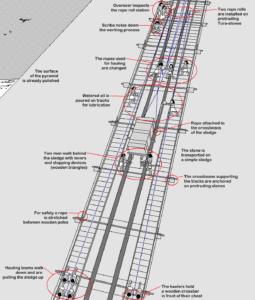While everyone these days makes a “making of” video, the ancient Egyptians decided to let their work speak for itself. They never tossed a video on YouTube explaining how they built the pyramids. So while there are a variety of theories about how they piled up all those stone blocks, even the most obsessed of Egyptologists don’t really know the answer.
Was it massive ramps, lifting cranes, elevators (yes, that has been suggested)? Ramps are a problem because to build a ramp or ramps to reach the top of the Great Pyramid would require as much or more work as it took to build the pyramids themselves. Lifting cranes are a possibility, but they require some heavy-duty wood to lift the multi-ton stone blocks (the Egyptians didn’t have wood of this quality and would need to import from a place like Lebanon). And the idea of wooden elevators inside the pyramid seems a little far fetched.
But there’s a German fellow named Franz Lohner who has a different theory on how the Great Pyramid was constructed. A former worker in a quarry, Lohner’s idea is that the builders made use of the sloped sides of the pyramid as their “ramp.”
According to Lohner, the Egyptians built a wooden track that was secured to the side of the pyramid. This track was used to lift the stones, which were lashed to wooden sledges. The tracks were lubricated with an oil and water mixture.
The true genius of Lohner’s idea, however, rests with the use of a primitive type of turning block that could change the direction of a lifting rope 180°. He calls these turning blocks “rope rolls.” The rope is led up through two rope rolls, one on either side of the track, and then back down the track to where two teams of workers make use of their own weight to head down the track, pulling the stone up. A clever idea that is far less expensive and time consuming than building massive ramps.
Even though the Egyptians didn’t have the wheel or pulleys, Lohner contends that inside one of the major pyramids there is an example of a log used to change the direction of ropes in this way. So the concept was likely not foreign to the clever engineers who built these massive structures.
Check out his site, which contains drawings and detailed explanations of his ideas. For pyramid fans, its well worth the visit. Who knows, maybe Lohner has cracked the case.

